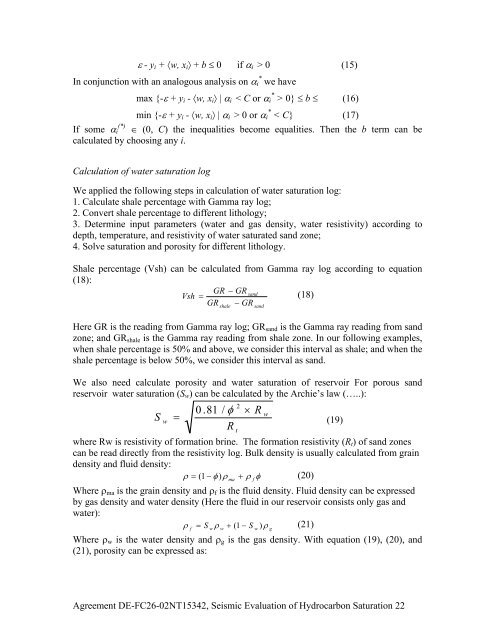Agreement DE-FC26-02NT15342, Seismic Evaluation of ...
Agreement DE-FC26-02NT15342, Seismic Evaluation of ...
Agreement DE-FC26-02NT15342, Seismic Evaluation of ...
You also want an ePaper? Increase the reach of your titles
YUMPU automatically turns print PDFs into web optimized ePapers that Google loves.
ε - y i + 〈w, x i 〉 + b ≤ 0 if α i > 0 (15)<br />
In conjunction with an analogous analysis on α * i we have<br />
max {-ε + y i - 〈w, x i 〉 | α i < C or α * i > 0} ≤ b ≤ (16)<br />
min {-ε + y i - 〈w, x i 〉 | α i > 0 or α * i < C} (17)<br />
(*)<br />
If some α i ∈ (0, C) the inequalities become equalities. Then the b term can be<br />
calculated by choosing any i.<br />
Calculation <strong>of</strong> water saturation log<br />
We applied the following steps in calculation <strong>of</strong> water saturation log:<br />
1. Calculate shale percentage with Gamma ray log;<br />
2. Convert shale percentage to different lithology;<br />
3. Determine input parameters (water and gas density, water resistivity) according to<br />
depth, temperature, and resistivity <strong>of</strong> water saturated sand zone;<br />
4. Solve saturation and porosity for different lithology.<br />
Shale percentage (Vsh) can be calculated from Gamma ray log according to equation<br />
(18):<br />
GR − GR<br />
sand<br />
Vsh = (18)<br />
GR − GR<br />
shale<br />
Here GR is the reading from Gamma ray log; GR sand is the Gamma ray reading from sand<br />
zone; and GR shale is the Gamma ray reading from shale zone. In our following examples,<br />
when shale percentage is 50% and above, we consider this interval as shale; and when the<br />
shale percentage is below 50%, we consider this interval as sand.<br />
We also need calculate porosity and water saturation <strong>of</strong> reservoir For porous sand<br />
reservoir water saturation (S w ) can be calculated by the Archie’s law (…..):<br />
S<br />
w<br />
=<br />
0 .81 / φ<br />
R<br />
t<br />
2<br />
×<br />
where Rw is resistivity <strong>of</strong> formation brine. The formation resistivity (R t ) <strong>of</strong> sand zones<br />
can be read directly from the resistivity log. Bulk density is usually calculated from grain<br />
density and fluid density:<br />
ρ = ( 1 − φ ) ρ ρ φ (20)<br />
ma +<br />
Where ρ ma is the grain density and ρ f is the fluid density. Fluid density can be expressed<br />
by gas density and water density (Here the fluid in our reservoir consists only gas and<br />
water):<br />
ρ<br />
f<br />
= S<br />
w<br />
ρ<br />
w<br />
+ ( 1 − S<br />
w<br />
) ρ (21)<br />
g<br />
Where ρ w is the water density and ρ g is the gas density. With equation (19), (20), and<br />
(21), porosity can be expressed as:<br />
f<br />
sand<br />
R<br />
w<br />
(19)<br />
<strong>Agreement</strong> <strong>DE</strong>-<strong>FC26</strong>-<strong>02NT15342</strong>, <strong>Seismic</strong> <strong>Evaluation</strong> <strong>of</strong> Hydrocarbon Saturation 22
















